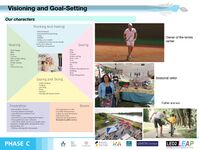LED2LEAP 2020 - Nuertingen Team 2: Difference between revisions
Jump to navigation
Jump to search
| Line 95: | Line 95: | ||
<gallery caption=" " widths="200px" heights="150px" perrow="5"> | <gallery caption=" " widths="200px" heights="150px" perrow="5"> | ||
File: | File:Characters.jpg|''add a caption'' | ||
</gallery> | </gallery> | ||
Revision as of 15:45, 14 May 2020
>>>back to working groups overview
| Area | Klein Tischardt | |
| Place | Nürtingen | |
| Country | Germany | |
| Topics | Interaction, Integration, Community, | |
| Author(s) | Alexander Koslov, David Jones, Steve Oberst, Timon Schröder | |

| ||
Landscape Democracy Rationale
- Everything with a decent age needs a renewal from time to time. But to fulfill this development correclty, we need everybody to pull on the string of everybodys needs in public spaces. So in the beginning it's very important to understand the surroundings. How is the age of the population? How many locals and foreigners are living there? Which oppurtunities for interaction are given? In which way dooes the population sees their landscape? The challenge will be to try to involve every citizen and their oppinion. Obviously not everyone will get pleased with the result, but at the end the goal should be to reflect what the general mood and ideas the inhabitants have and how they could be realized.
Location and scope
- Location : Germany, Nürtingen 72622, Klein Tischardt
Phase A: Mapping your Community
Welcome to your community and its landscape
- The Klein Tischardt district is located in Nürtingen, a small town in southern Germany. It borders on the old town and has a village character. The many small shops, which often only consist of garages, are striking. On the edge there is a commercial area with a shopping center. In the center there is an old people's home with assisted living.
Groups of actors and stakeholders in your community
- There are two large groups that are located in the district. The first are small businesses that are spread throughout the district and the second are senior citizens who live in and around the nursing home. The first group has a service relationship with all residents and is accordingly also clearly visible. The second group, however, is more in one place and rarely leaves it. Another group are the young people, who are also rarely seen, because the neighborhood has few cool meeting places. So far we can only guess how everyday life in the neighborhood really works and which groups interact with each other.
Relationships between your actors and groups
- The group of small businesses has the most influence because they own land and are visible. In addition, the residents are dependent on the services of these e.g. Shopping center. We think that all groups have the following interests in common: a good infrastructure, public lounges in nature and shopping.
Summary of your learnings from the transnational discussion panel on April 22
On April 22 you will present the PPT version of this first assignment to other seminar groups working in other geographical community contexts. Please give here a short summary of your learnings during this presentation, for example:
- Other analytical approaches
- Other representation styles
- Other value schemes: any surprises?
- Constructive comments we received on our presentation
Theory reflection
- Reflect on at least three readings from the first section 'Democratic Landscape Transformation
- You can choose references from our reading list or suggest others
- Scope: 250 words
References
- give a full list of the references you have used for this section
Phase B: Democratic Landscape Analysis and Assessment
The Scene in your Story of Analysis
- The challenge of the project is to involve every commmunity with their needs and desires. The landscape has a rural and the atmosphere of the distict has an oldschool touch. The most noticeble things missing are recreation spaces. There are many stackeholders in the disctrict with the same political power/influence. Only the local shops have a little bit more power because of the dependence of supplys.
The Actors in your Story of Analysis
- Describe the characters and their role in the story. Are they major or minor characters? Are there any key relationships that need to be defined?
- add the corresponding visual from your presentation to the image gallery below
The Story of Analysis
- Describe the plot of the story and how it plays out.
- add the corresponding visual from your presentation to the image gallery below
- add as many additional images as you like
- Yourcase story2.jpg
add a caption
Reflect on your Story of Analysis
- How did the tools you chose for landscape analysis fit your community? Reflect on the questions: What did you carry? Why did you carry? How did you carry? What remains after you've left? (150 words)
- add the corresponding visual from your presentation to the image gallery below
- Yourcase refelction1.jpg
add a caption
Phase C: Collaborative Visioning and Goal Setting
* template coming
Phase D: Collaborative Design, Transformation and Planning
* template coming
Phase E: Collaborative Design, Transformation and Planning
* template coming
= Phase E: Collaborative Evaluation and Future Agendas * template coming
Process Reflection
- Reflect in your intercultural and interdisciplinary team on the outcomes of your study
- Which limitations were you facing?
- What have you learnt from each other?
- What would you do differently next time?
- You can also use diagrams/visuals
- 250 words text








